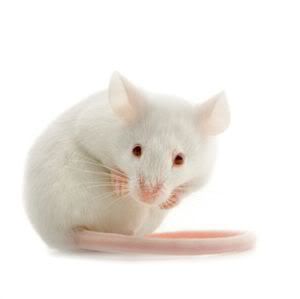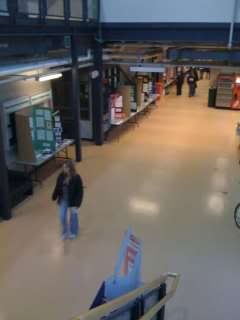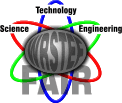Archive for April 2009
Crossroads Cafe & BBQ

I feel as if I should do my part to promote and support some local business that I have happened upon in my search of hidden gems around the city. Being of European descent and having grown up with eastern European cuisine, I have an insatiable hunger for all things of that kitchen.
It is in the search to satiate this hunger that I happened upon the tiniest of restaurants, named Crossroads Cafe and Barbecue on Ottawa street in Windsor. The entire establishment is run by a pleasant Polish woman who takes care of both the orders and cooking simultaneously. Even though the restaurant seats no more than 20 people, this is quite the feat! Especially since the establishment is never lacking patrons.
The food is amazing and keeps you coming back. The soups are a highlight for me, but anything served on the menu is highly recommended, from the hand battered and tenderized schnitzel to the homemade perogies, everything is simply delicious.
Nothing on the menu is over $10.
Bon appetite!
Can Cancer Be Cured by 2015?

So I have my final examination this morning in the subject of cell transformation, better known as cancer. The final is worth a whopping 40% and is based on subject matter presented by the roughly 25 students enrolled in the class over the past two months, including my own presentation on the effects of the Chernobyl nuclear accident.
You can pretty much stop reading here. The rest of this post unnecessarily goes into summarizing one of the essay questions I will be writing today and basically serves as a rough draft.
One of the central questions to be addressed by the examination was given to us, along with a review paper, ahead of time: can cancer be cured by the year 2015? This extremely engaging question pretty much tests your knowledge on the subject of the course and asks for a conclusion to be made from your understandings of the underlying mechanisms surrounding the many types of cancers, carcinogens, environmental factors etc. associated with carcinogenesis.
I will do my best to posit that cancer will not be 'cured' as a whole come 2015, but will morph into a controllable illness sometime in the near future, with which afflicted individuals will learn to live much like diabetes sufferers. The vast amounts of cell regulatory pathways that play a role in giving rise to a cancer within humans is the central reason for which I believe a cure is not likely; there is always another undiscovered or overlooked signaling pathways through which cellular mechanisms can be hijacked and used to transform regular cells into cancerous ones.
The paper mentioned above highlighted some of the pathways through which current technology aims to fight cancer; through cancer-specific agents, selective combinations and tissue-selective therapy.
Cancer-specific agents aim to target cancerous cells directly, through their cellular abnormalities, to selectively kill them. The discovery of abnormal cellular pathways being directly related to a particular cancer yields the possibility of targeted therapy that exploits this exclusivity. Gleevec is a model example of this, with its targeting of a philadelphia chromosome abnormality, the BCR-Abl protein, to prohibit it from acting as an agent that promotes cellular division specifically in cancerous growths.
Selective combinations use universally cytotoxic elements with selective agents to target cells within the body that are again exhibiting abnormal cellular activity. The main example being the administration of DOX, UCN-01 and the cytotoxic agent PTX in an attempt to eliminate all cells incapable of reacting to the former two's effects in normal cells in relation to tumor suppression protein activity.
Tissue-specific cancer treatment aims to exploit the innate differences of differentiated cell types; for instance, exhibiting a myriad of different surface proteins directly associated with specific tissue types. In essence, all cancers have a direct tissue origin that can be exploited. Rituximab, an antibody based therapeutic agent, targets CD20, a specific cell surface marker present on both cancerous and normal B cells within the body; this binding is associated with marked increase of apoptosis of these cells through as of yet unclear reasons. Tissue-specific antibodies can also be used with the aid of radioimmunotherapy to selectively destroy marked cells.
Each of these therapies are entirely open to new discoveries that will undoubtedly strengthen their ability to target and eradicate particular cancerous cells; however, each of these therapies is also marked with the deficiency of selecting for cells that circumvent the targeted treatment and thus give rise to even more resistant forms of cancer upon treatment. It is for this reason that these strategies must be used in conjunction with each other, either in series or, if allowable, together, to rid the body of as many cancerous cells as possible. The idea of using opposite therapies to rid of the selected resistant cells of the previous modality is a necessary step that will lead to eventual regression of the cancer, or a continued opposite therapy schedule that will suppress the cancer indefinitely. In this way, cancer will become a chronic illness with which patients will be able to cope in a relatively non-invasive fashion, akin to patients having to deal with diabetes.
Shot in the dark? I give it until 2020 to see these kinds of results.
WRSTEF - Part II

What interesting day yesterday was! As anticipated, I genuinely felt tired enough to postpone writing the entry until late in the evening, but the enthusiasm for the event had not decreased by any degree.
First and foremost, I have to applaud the myriad of kids that came attended the science fair, over two hundred exhibits were showcased; I know firsthand how harrowing this experience can be, especially when you are in the junior grades. There were also a large amount of judges, many of which, as I later overheard, were incentivized into their positions with promises of bonus credits in their respective courses at the University and St. Clair College.
My group, consisting of three others and myself, were tasked with judging four projects, at the grade 4 level, for scientific content, ingenuity and presentation. Our marks consisted of a percentage score that may correspond to a medal if above 75%, with no limitations on any particular awarding of medals.
The interesting part came when I realized all the projects my group was tasked to judge were written, and later explained by the students, in French. I am only partially fluent in French, the reading and listening part—I had not advertised this rather poorly honed skill at any time during the application process. When I went to rectify the situation, the administrators asked if I would kindly consider continuing with the assigned groups, most likely because I was able to quickly translate the written titles of the projects on my documentation. I quickly understood that this whole situation was not a problem for my group members, as they were all bilingual; funny.
In hind sight, I am glad that this happened. I definitely got to work on my French today, clearly understanding all of the four assigned projects, listening intently to the wonderful presentations by the kids and understanding their answers to my inquiries, which I bashfully asked in English, upon their consent.
Out of the four projects, one stood out as my groups clear favourite; done by two girls, whose names I unfortunately do not remember at this point. The projects looked at the cleanliness of apples directly from the store, as well as the efficacy of different detergents and methods to rid the fruits of bacteria. The bacterial presence was qualitatively observed through petri dish growth upon swabbing of market fresh apples, as well as those that have been cleaned through rubbing on one's shirt, a solution of vinegar and water, and a fruit and vegetable detergent (something I had no clue existed). The scientific method was captured in its entirety, with multiple trials, controls and other aspects that were above what I expected from this grade level. The girls also knew their project very thoroughly, which for me, dismissed parental involvement to a large degree. The best part of their presentation, apart from their matching green polka-dot dresses to match the green apples they tested, was their self critical stance on their project—they distinctly knew their weaknesses and knew exactly what to do in order to correct them. I hope to publish their names and the project picture as soon as it becomes available on the Windsor Regional Science, Technology and Engineering Fair website.
Very interesting experience. I cannot wait until my little sister is of age to participate in one of these events, I am looking forward to guiding her in this experience as she needs it.
Windsor Regional Science, Technology and Engineering Fair (WRSTEF)

Last semester, during a lecture in my drug design course, there was an small intermission to allow an associate professor of the chemistry department to speak to our rather minute class. He asked for assistance from the class for an upcoming grade and high school science fair, the WRSTEF, that needed knowledgeable senior students enrolled in the sciences to help judge submissions. My interest was peaked, as I clearly remember my own grade school science project, relating to cryogenics, which aided in spurring my interest in science, although at the expense of many a frozen cricket.
I am writing this post in advance of the actual science fair, so excuse me if I butcher the tenses here; understand that I am yet to awake at the unforgiving hour of 6:00 am in order to arrive punctually at 7:30 am and begin the judging process, along with other volunteers, at approximately 8:30 am.
The judging is supposed to be a multifaceted role, as the judge's itinerary proposes; it involves both scoring the projects as well as interacting and guiding the kids who are responsible for them. There will be projects presented by children from grades 3 through 12—I am particularly keen on seeing some of the things the younger kids present, seeing as my little sister will soon want to partake in this type of fair and will undoubtedly be coming to me for guidance.
Depending on my excitement or, more likely, overall fatigue, I will post some of the highlights of the fair later today or as tomorrow's post.

